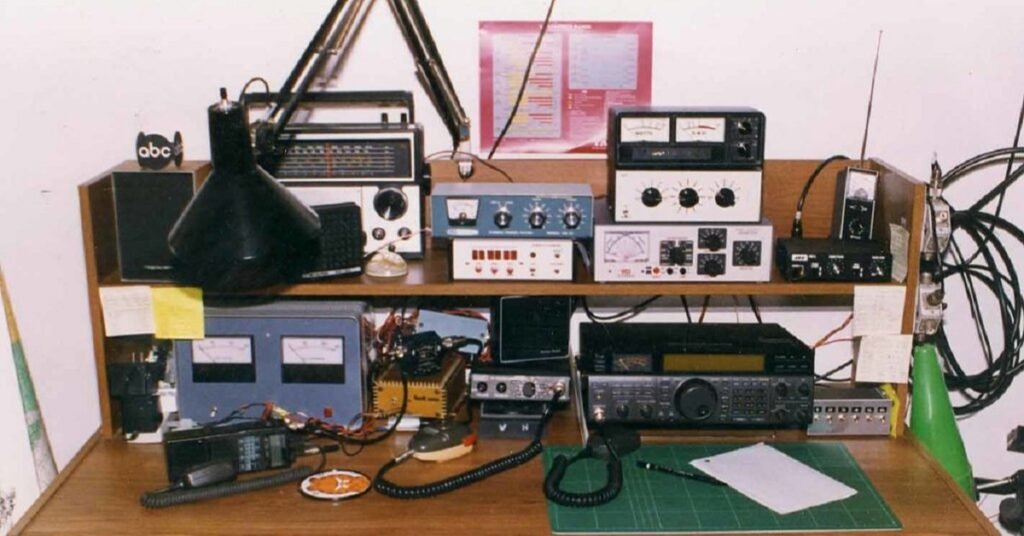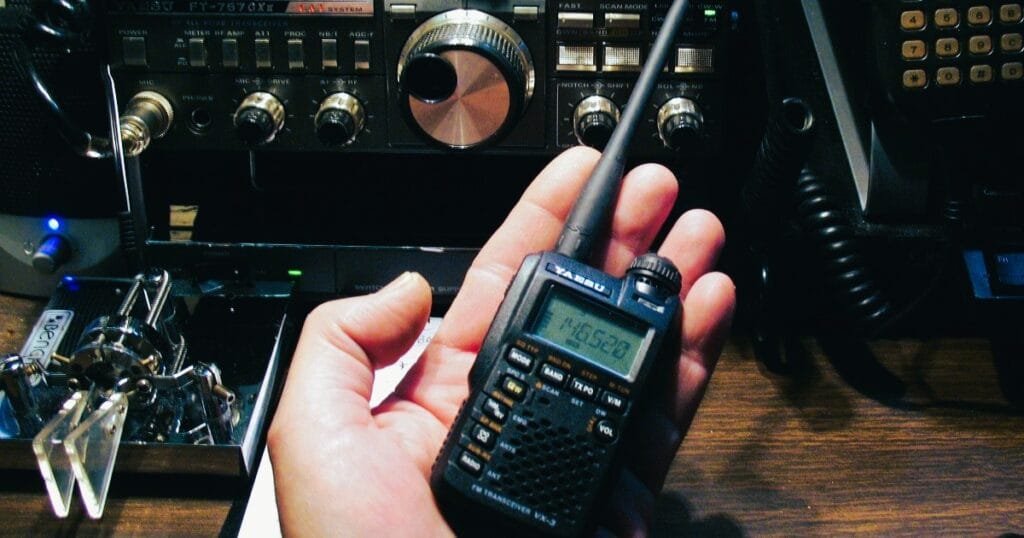Table of Contents
ToggleSetting Up a Ham Radio Base Station: From Zero to Hero
Hello, friends of the airwaves! Welcome back to TalkieTrail, where we adjust knobs, flick switches, and sometimes shout at tangled connections so you don’t have to. Yesterday, I set up a brand new base station because I changed my workstation. That’s why I had to reset everything and also change some parts for an upgrade. Today, I’m going to guide you through the procedure step by step, with just enough comedy to keep you from throwing your transceiver out the window.
What’s a Ham Radio Base Station, Anyway?
Imagine the Batcave, except instead of crime-fighting devices, it’s full with radio equipment. That’s your ham radio base station—a permanent installation that transforms your home into the ultimate communication center. It is comparable to trading in a bicycle for a race car. A base station is to your favorite handheld or walkie-talkie what a basement full of power tools and antennae and the ability to say, “ this one goes up go way farther than this one over here,” which translates as: they work better.
But what makes a base station so unique? Think of it as a ham radio headquarters. This system is not something you can put in your bag for a weekend walk. Instead, it is a permanent, powerful communication station located in your own house. Whether you’re talking to someone across town or communicating with a fellow ham halfway around the world, a base station is your passport to high-quality radio operating.
Why Bother with a Base Station?
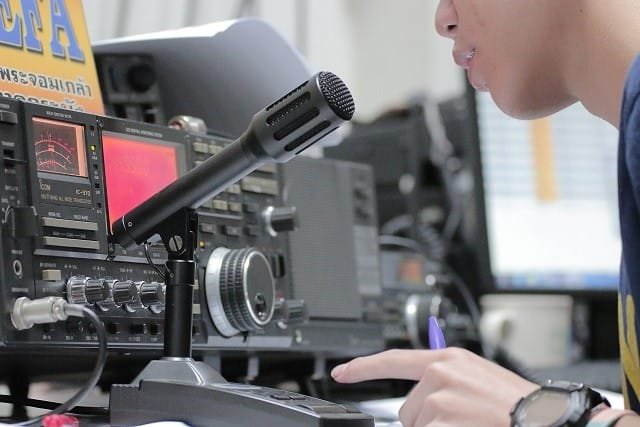
You might be saying, “I have my hand held, I am all good.” But hang on! There are a lot of good reasons to go big with a ham radio base station.
1. Talk to the World
A base station, with its increased power and larger antennae, enables you to communicate with folks on the opposite side of the earth. Whether you’re establishing DX contacts or simply increasing your communication range, the globe is your playground.
2. Crystal Clear Communication
Base stations provide that luscious, wonderful signal clarity. No more yelling at the microphone or repeating oneself ten times. You’ll notice far less noise and interference, and your signals will be crisper and more constant.
3. Feature-Rich Experience
Handheld radios are ideal for mobility, but base stations come with all the bells and whistles. Your base station converts you into the airwaves’ James Bond, with digital signal processing, superior filtering, and multiple band support. You’ll have tools at your disposal that make communicating not just simple but entertaining.
4. Comfort is King
Operating a base station means you’re no longer bent over a little radio. Set up your gear in your favorite chair, add a large screen, and you’ll be living the dream. It’s like moving from a loud, tight cockpit to a luxurious plane.
The Must-Have Components for Your Base Station
Obviously, setting up a base station for radio communication is not an easy task. To get your base station up and going, you’ll need a few key components. Let us break down the must-haves:
1. Transceiver: The Heart of Your Base Station
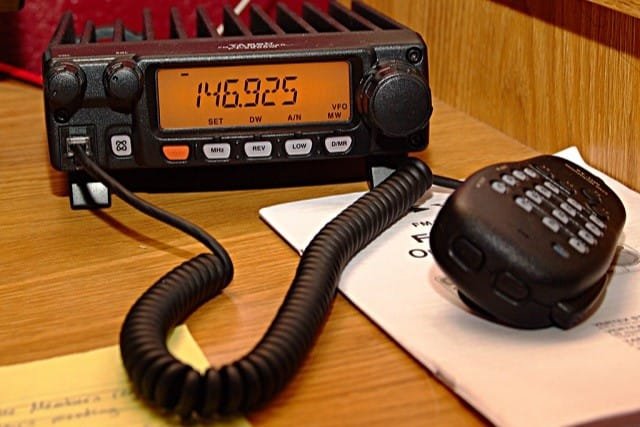
Without a doubt, the transceiver is your base station’s principal component. This gadget lets you send and receive signals at a variety of frequencies and bands. When selecting a transceiver, consider your needs and price range. Brands such as Icom, Yaesu, and Kenwood are the radio industry’s equivalent of luxury automobiles—high performance, dependability, and feature rich.
There are lots of transceivers on the market. You can choose one, but always check honest reviews. Click here to learn the pros and cons of the ICOM IC-756PROIII.
2. Power Supply: The Heart of Your Setup
A stable power supply is vital for your base station because it guarantees consistent operation and predictable performance, both of which are critical for efficient communication and system stability. Make sure your power supply meets the needs of your transceiver. Don’t scrimp on quality here, or you’ll be in for some nasty shocks when your station abruptly shuts down in the middle of your discussion.
3. Antenna: Your Voice to the World
Your antenna is likely the most important part of your base station. It has a major impact on how well your message is received and comprehended by your audience as well as how far your communication may travel. Whether you choose a vertical, dipole, beam, or loop antenna, the aim is to adapt it to your station’s operating frequencies and available area.
Does an antenna really help extend connection? Check here.
4. Antenna Tuner: The Performance Booster

An antenna tuner ensures that your base station runs efficiently by matching the impedance of your transceiver and antenna. Consider it the fine-tuning tool for your radio setup—essential for peak performance.
Confused? Want more information about antenna tuners? Just click here to read in detail.
5. Unsung Heroes: Coaxial Cables and Connectors
Even though the high-quality coaxial cables and connectors can be forgotten as they go behind your walls, they are vital to have at your base station. Low-quality cables will lead to signal loss, interference and unintended degradation. Spend the money on quality now to save you hours and days of troubleshooting later.
How to Choose the Perfect Coax for Your Ham Radio Setup? Read here.
6. Grounding System: Safety and Performance in One
A perfect grounding system is very important not only for safety but also for the good performance of your base station. Grounding your equipment provides protection against electrical risks and decreases interference. It’s also an excellent reason to get some shiny copper wire and get your hands dirty with a grounding rod.
7. Microphone and Keyer: Your Tools of Communication

Whether you’re talking up a storm or typing out Morse code, invest in a high-quality microphone or keyer for your base station. Clear audio and precise keying will make you a hit on the radio.
Check here how I chose the best microphone for ham radio.
8. Computer and Software: Going Digital
Integrating your base station with a computer can help it perform better. With the correct software, you can register contacts, use digital modes, and even control your station remotely. You have access to the digital world through FT8 and PSK31.
Let’s Get This Base Station Set Up!
With your stuff in hand, it is time to get everything ready. Do not touch a thing–time we put everything together like IKEA furniture (sans the extra screws at the end).
1. Pick the Perfect Spot for Your Base Station
When it comes to base station setup, location is crucial. You’ll need ample space for all of your gear, enough ventilation, and low electrical interference. The best places are a quiet corner or a different room; just watch out that you’re not too close to the refrigerator. It loves to hum along while interfering with your signals.
2. Antenna Installation: Aim High
As it directly affects signal strength and communication quality, antenna location is a critical factor in determining the overall efficacy and performance of your base station. Ideally, you want your antenna as high as possible and free of obstacles like trees, buildings, or your neighbor’s too interested dog. Just make sure to avoid using duct tape this time.
3. Connect the Dots: Wiring Your Base Station
Now comes the fun part: connect the dots with your equipment. Start by connecting your transceiver, power supply, antenna tuner, and antenna using high-quality coaxial wires. Make sure everything is connected correctly; unreliable connections impede efficient operations.
4. Ground It All: Safety First
Grounding is not limited to antennas; your complete base station equipment must be properly grounded. Use grounding rods and cables to connect all of your equipment to a single ground point. This step improves performance while simultaneously ensuring safety. Plus, who doesn’t like the opportunity to wield a hammer and feel like Thor?
5. Configure Your Transceiver: Tuning into the World
To guarantee the best possible setup and performance, configure your transceiver’s frequencies and bands in accordance with the comprehensive instructions found in the handbook. Each model has its own peculiarities, so avoid skipping the steps. Proper setting is essential for ensuring that your base station runs well. Remember to tweak your antenna tuner as well; it’s similar to tuning your guitar before a performance.
6. The Final Test: Prepare for the Moment of Truth
So get ready. It’s time to test your base station. Monitor your SWR (Standing Wave Ratio) while you transmit and receive signals. Here is where the fine-tuning occurs. Adjust your SWR till it meets your needs if it isn’t ideal. Consider it similar to creating a dish, except this one connects you to the entire globe.
7. Organize Like a Pro: No Chaos Allowed
Make sure that every component is readily accessible for efficient usage and maintenance, label your cords, and organize your modules in a methodical manner. A well-organized base station is not only visually appealing; it also makes operation simpler and more fun. Not just disorder, but “organized chaos” is what you are aiming for.
Operating Your Base Station Like a Boss
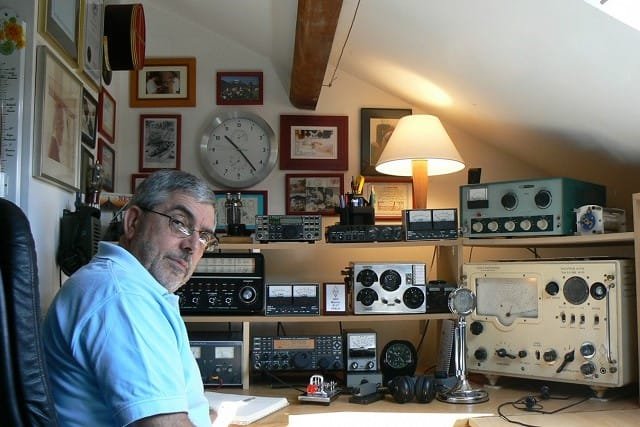
Congratulations! Your base station is up and functioning. Let’s now discuss how to maintain it that way and take full use of your newly configured setup.
1. Maintenance is Key: Keep Things Running Smoothly
Regular maintenance is necessary to keep your base station operating at peak performance. Regularly inspect your antenna for damage, make sure all connections are secure, and clean your equipment. Your station will provide you with dependable service and endure for many years if you take excellent care of it.
2. Keep Up: Information Is Power
Ham radio is a constantly changing pastime. Keep up with the latest news, technology, and regulations to guarantee that your base station is constantly performing at its peak. Subscribe to ham radio periodicals, participate in internet forums, and never stop learning.
3. Join the Club: Ham Radio Community
That is of course where it would be a best fit for the amateur radio community. Get on the air, attend rallies / contests and local ham club meetings with some kind of image (photographer can assist) so you will be easy to recognize when calling- get a flag and patch as well. You will meet wonderful people, and you stand to learn a lot. Haha, because who wouldn’t want to show off with their brand new fancy base station.
4. Experiment and Innovate: Never Stop Exploring
Ham radio is all about experimenting. Try a variety of modes, frequencies, and configuration adjustments to see what works best. You’ll learn more the more you experiment with your base station; you could even discover something truly innovative.
Final Thoughts: From Humble Beginnings to Radio Greatness
Installing a ham radio base station is an adventure, and much like any worthwhile journey, it involves setbacks, successes, and moments when you ask yourself, “What exactly is this part for?” But once everything is in place, all the hams will be jealous of you. You can design a strong and interesting to use station with a little planning, patience, and enthusiasm.
Stay tuned to TalkieTrail.com for more amateur radio advice, guidelines, and tips.
Happy functioning, and 73 to the TalkieTrail crew!
